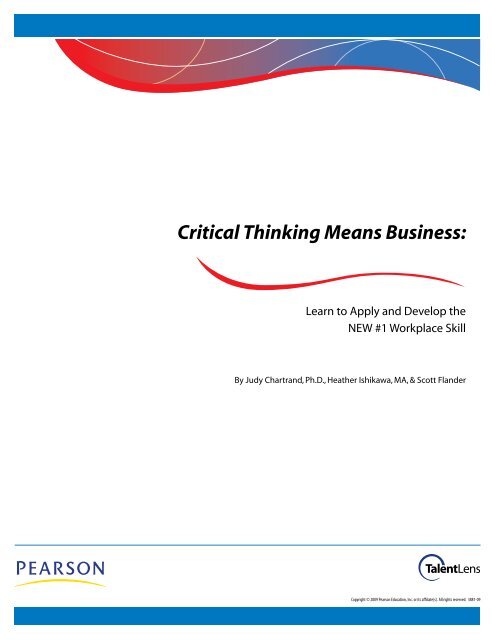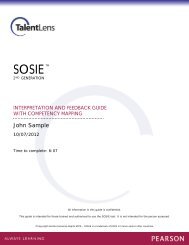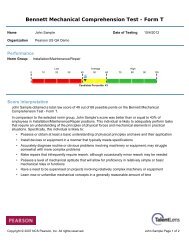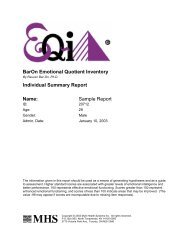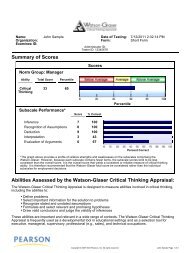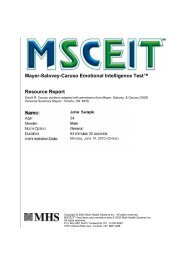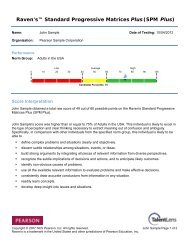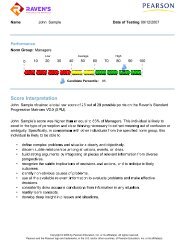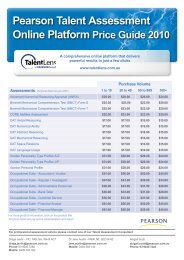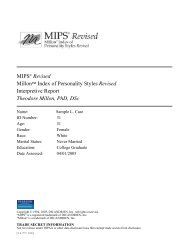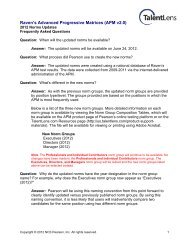Critical Thinking Means Business (374.34 KB) - Pearson TalentLens
Critical Thinking Means Business (374.34 KB) - Pearson TalentLens
Critical Thinking Means Business (374.34 KB) - Pearson TalentLens
You also want an ePaper? Increase the reach of your titles
YUMPU automatically turns print PDFs into web optimized ePapers that Google loves.
<strong>Critical</strong> <strong>Thinking</strong> <strong>Means</strong> <strong>Business</strong>:Learn to Apply and Develop theNEW #1 Workplace SkillBy Judy Chartrand, Ph.D., Heather Ishikawa, MA, & Scott FlanderCopyright © 2009 <strong>Pearson</strong> Education, Inc. or its affiliate(s). All rights reserved. 3881-09
Table of ContentsIntroduction to <strong>Critical</strong> <strong>Thinking</strong> <strong>Means</strong> <strong>Business</strong> ...................................................... 1Too Little <strong>Critical</strong> <strong>Thinking</strong> = Big Problems .................................................................. 2-3<strong>Critical</strong> <strong>Thinking</strong> in the Workplace ................................................................................. 4How <strong>Critical</strong> <strong>Thinking</strong> Works: Introduction to the RED Model .................................. 5Using the RED Model in Decision Making: A Case Study ........................................... 6For Trainers - Developing <strong>Critical</strong> Thinkers and Problem SolversUsing the RED Model: A Sample Training Program ................................................... 7Conclusion .......................................................................................................................... 8References .......................................................................................................................... 9
Too Little <strong>Critical</strong> <strong>Thinking</strong> = Big ProblemsThe U.S. Department of Labor has identifiedcritical thinking as the raw material of a numberof key workplace skills, such as problem solving,decision making, organizational planning andrisk management. There is no lack of examplesof what happens when an absence of criticalthinking in business cascades into a completesystems failure.the company miscalculated on several fronts. Itfailed to fully consider what the public reactionmight be, not only to the firings, but to the lack ofexperienced staff on the sales floor. It seemed thecompany was so focused on the bottom line, itfailed to look at the larger picture. These are signsof a breakdown in critical thinking.In 2007, Circuit City fired 3,400 of its highest paidstore employees, saying it needed to make thecuts to remain competitive with Best Buy andother electronics retailers. The employees, thecompany said in a statement, had previously beengiven raises by managers that paid them “abovethe market-based salary range for their role,” andwould be replaced by workers making less money.The move resulted in a storm of public reaction.News stories quoted angry consumers who vowedto boycott Circuit City for what they consideredshabby treatment of successful employees. Salesof big-ticket items – such as flat-panel televisions– dropped off suddenly and sharply, forcingthe company to revise its revenue estimatesdownward. Industry analysts blamed the poorsales on the job cuts, saying that when consumersbuy expensive, complicated electronics, theyexpect the sales staff to be experienced andknowledgeable. Shoppers likely were reluctantto take a chance at Circuit City, the analysts said. 3The company downplayed the possibility thatreduced sales were related to the firings, sayingthat only two or three salespeople per store, onaverage, were cut.While it is impossible to know exactly what wenton in Circuit City’s executive offices, it is clearA window into the company’s thought processcan be found in its suggestion that because fewemployees per store were fired, the drop in salesof expensive items was probably not related. Buthow many would-be shoppers did encounterinexperienced sales staff, and walked out emptyhanded?And how many more simply stayed awayfrom Circuit City altogether because they hadseen the news reports, and did not expect to findknowledgeable employees? Public perceptionno doubt played an important role in the entireaffair, something the company – even in the faceof disaster – apparently failed to comprehend.The firings may even have contributed to thecompany’s eventual demise. Circuit City continuedto lose ground in the electronics wars, and couldnot survive the recession. The chain liquidated allof its stores in 2008 and 2009.A failure in critical thinking may have alsosabotaged an ambitious plan by UK-based Tesco,the world’s third-largest retailer, to blanket the2Copyright © 2009 <strong>Pearson</strong> Education, Inc. or its affiliate(s). All rights reserved.
Too Little <strong>Critical</strong> <strong>Thinking</strong> = Big Problems continued…West Coast of the U.S. with a chain of small grocerystores focusing on fresh foods. Prior to openingits first Fresh & Easy stores, Tesco conductedan extraordinary level of market research, withTesco executives living in the homes of Americanconsumers to observe their eating and shoppinghabits.However, the Fresh & Easy concept failed to catchfire, and expansion plans for the chain werescaled back. Tim Mason, the head of Tesco’s U.S.business, said that despite the intensive marketresearch, the company failed to realize thatAmericans would not be content with Fresh &Easy’s “everyday-low-prices” strategy, and wantedto see coupons and other special offers.A comment Mason made later to The Timesof London was particularly revealing of thecompany’s thought process. “There’s less loyaltyin the American market,” Mason said. “A Brit hasto hear it a few times before [they] accept thatpeople make up their minds each week whenthey check out the special offers.” 4 Mason wassuggesting that the marketing executives hadbeen told of the importance of special offers, butthe information didn’t register with them becauseit didn’t correspond to the way British peopleshop. In other words, the executives apparentlywere unable to clearly evaluate evidence becauseof preconceived notions – a classic example of alack of critical thinking.888.298.6227 | <strong>TalentLens</strong>.com3Copyright © 2009 <strong>Pearson</strong> Education, Inc. or its affiliate(s). All rights reserved.
<strong>Critical</strong> <strong>Thinking</strong> in the WorkplaceResearch conducted in recent years by <strong>Pearson</strong>,as well as by a variety of independent academics,has shown that people who score well on criticalthinking assessment are also rated by theirsupervisors as having: Good analysis and problem-solving skills. Good judgment and decision making. Good overall job performance. The ability to evaluate the quality ofinformation presented. Creativity. Job knowledge. The potential to move up within theorganization.Because it is often difficult to discern such criticalthinking skills through a resume or job interview,many organizations are turning to assessmentsto help them evaluate candidates. One of themost widely used assessments in this area is theWatson-Glaser <strong>Critical</strong> <strong>Thinking</strong> Appraisal, from<strong>Pearson</strong> <strong>TalentLens</strong>. The Watson-Glaser offers ahard-skills appraisal, and is suited for people inprofessional and managerial positions.Perhaps not surprisingly, independent researchhas also found that the higher up the ladder aposition is, the more essential critical thinkingbecomes. People who are successful in thesepositions tend to be able to learn quickly,process information accurately, and are ableto apply it to decision-making. One of themost well-established research findings inindustrial psychology is that cognitive abilityis directly related to performance in all jobs 5 .<strong>Critical</strong> thinking, one type of cognitive ability,is of particular importance where sophisticateddecision-making and judgment are required.It is not uncommon for organizations to ignoresuch research findings when they are engagedin succession planning or top-level executivesearches. Organizations often assume thateveryone at the highest corporate levels is brightand a “good thinker,” so they don’t assess theircandidates’ critical thinking capabilities. However,a 2009 study by Ones and Dilchert 6 found thatthere is variability in critical thinking abilitywithin groups of executives (as well as amongsupervisors and managers). Although executivesgenerally did perform better on critical thinkingtests when compared with other groups, therewas a wide range of higher and lower scores.Simply put, the research found that some topexecutives are better at critical thinking thanothers – and so are likely to be more successful.It is important to note that research has alsofound a positive correlation between certainpersonality characteristics and job success.Consequently, organizations that include bothcritical thinking and personality in their battery ofassessments tend to get a more comprehensiveview of a candidate than do organizationsthat use either personality or critical thinkingassessments alone.Organizations often assume thateveryone at the highest corporate levelsis bright and a “good thinker,” so theydon’t assess their candidates’ criticalthinking abilities.4Copyright © 2009 <strong>Pearson</strong> Education, Inc. or its affiliate(s). All rights reserved.
How <strong>Critical</strong> <strong>Thinking</strong> Works:Introduction to the RED ModelKeys toCRITICALTHINKINGREDecognize Assumptionsvaluate Argumentsraw ConclusionsFortunately, critical thinking can be taught.<strong>Pearson</strong> has developed the following RED Model– Recognize Assumptions, Evaluate Arguments,Draw Conclusions – as a way to view and applycritical thinking principles when faced with adecision. This model is particularly helpful incritical-thinking training programs.Recognize Assumptions. This is the abilityto separate fact from opinion. It is deceptivelyeasy to listen to a comment or presentation andassume the information presented is true eventhough no evidence was given to back it up.Perhaps the speaker is particularly credible ortrustworthy, or the information makes sense ormatches our own view. We just don’t questionit. Noticing and questioning assumptions helpsto reveal information gaps or unfounded logic.Taking it a step further, when we examineassumptions through the eyes of different people(e.g., the viewpoint of different stakeholders),the end result is a richer perspective on a topic.Evaluate Arguments. It is difficult to suspendjudgment and systematically walk throughvarious arguments and information with theimpartiality of a Sherlock Holmes. The artof evaluating arguments entails analyzinginformation objectively and accurately,questioning the quality of supporting evidence,and understanding how emotion influences thesituation. Common barriers include confirmationbias, which is the tendency to seek out andagree with information that is consistent withyou own point of view, or allowing emotions –yours or others – to get in the way of objectiveevaluation. People may quickly come to aconclusion simply to avoid conflict. Being ableto remain objective and sort through the validityof different positions helps people draw moreaccurate conclusions.Draw Conclusions. People who possess this skillare able to bring diverse information togetherto arrive at conclusions that logically followfrom the available evidence, and they do notinappropriately generalize beyond the evidence.Furthermore, they will change their positionwhen the evidence warrants doing so. They areoften characterized as having “good judgment”because they typically arrive at a quality decision.Each of these critical thinking skills fits togetherin a process that is both fluid and sequential.When presented with information, peopletypically alternate between recognizingassumptions and evaluating arguments. <strong>Critical</strong>thinking is sequential in that recognizing faultyassumptions or weak arguments improves thelikelihood of reaching an appropriate conclusion.Although this process is fluid, it is helpful tofocus on each of the RED skills individually whenpracticing skill development. With concentratedpractice over time, typically several months,critical thinking skills can be significantlyincreased.888.298.6227 | <strong>TalentLens</strong>.com5Copyright © 2009 <strong>Pearson</strong> Education, Inc. or its affiliate(s). All rights reserved.
Using the RED Model in Decision Making: A Case StudyMaking Dentists Feel Comfortable During thePurchasing ProcessA company that sold medical equipment directlyto dentists had what appeared to be a minor,easy-to-solve problem. The company’s salesrepresentatives reported that they were havingdifficulty selling new equipment because thedentists had a number of technical questionsthat went beyond the reps’ knowledge. The salesstaff requested that this technical information beput on the company’s Web site, so that it couldbe accessed by the dentists.This seemed like a very reasonable request.Company executives were familiar with surveysthat said dentists liked to search online for thelatest information and developments in theirfield. The executives checked with companycustomer-service reps, who also reported thatdentists were asking a lot of technical questionsabout the new equipment. After studying theissue, the company redesigned its Web site,providing a wealth of technical informationabout its equipment.But the changes had no effect whatsoever.Sales of the new equipment remained sluggish.Dentists continued to ask sales representativesfor additional technical information – even afterthey were referred to the revamped Web site.To understand what was happening, severalcompany executives met informally withdentists whom they knew were in the market fornew equipment. Through these conversations,the executives learned that the dentists didn’tfeel comfortable during the purchasing process.What they really wanted, though they didn’texplicitly ask for it, was to talk to someone atthe company – a peer – who could walk withthem through the entire process, answeringtheir questions honestly and knowledgably.Essentially, they didn’t want a salesperson or aWeb site – they wanted a coach.By examining the RED Model, it can be seenwhere the company went wrong:Recognize Assumptions: The executives hadassumed the sales staff had an accurate handleon the situation. But the executives had neverasked the reps how deeply they had probed intothe customers’ concerns.Evaluate Arguments: The executives later recalledthat during a meeting on the issue, a managerhad recommended hiring a retired, highlyregarded dentist who could help the customerson a peer-to-peer level. The suggestion had beenquickly dismissed because of the cost. Othersat the meeting noted that updating the Website would be far cheaper. The executives alsolater remembered that while surveys did showthat dentists like to get information online, thesurveys also revealed that dentists don’t fullytrust the information unless they can verify itwith someone they trust – such as a peer. Theexecutives realized that they had chosen to focuson the portion of the research that suggested acheaper solution.Draw Conclusions: The executives had taken theevidence they possessed – the dentists’ technicalquestions – at face value, without consideringthat people do not always clearly ask for whatthey want.Had the company executives recognized theiroperating assumptions – and questioned themone by one; had they fairly evaluated alternativearguments and points of view; and had theydispassionately analyzed the informationavailable before drawing any conclusions; theymay have been able to quickly identify andaddress the underlying issue. As is often the case,there wasn’t an isolated breakdown in criticalthinking here. There was a systemic, cascadingfailure.By examining the RED Model, it can beseen where the company went wrong.6Copyright © 2009 <strong>Pearson</strong> Education, Inc. or its affiliate(s). All rights reserved.
Conclusion<strong>Critical</strong> thinking is the lifeblood of the most essential workplace skills, including problem solving,decision making, good judgment and sound analysis. Organizations that can attract, retain and developthe best critical thinkers have a significant and measurable competitive advantage in the businessworld.Yet business suffers from a severe shortage of critical thinkers. Too few employees come to their jobswith these skills, and too few have the opportunity to develop them in the workplace. The good news,however, is that critical thinking can be taught, and applied directly to on-the-job problems anddecisions. The easy-to-use RED model is a breakthrough in approaching what until now has been amostly abstract and elusive concept. The RED model lays out a path for understanding how criticalthinking works, and for developing each of the essential skills.The return on investment for critical thinking training tends to be extremely high. One company reported17x ROI. And as a whole, participants in an onsite <strong>Critical</strong> <strong>Thinking</strong> Boot Camp workshop reported 74%of employees actually applying the new skills. Other research has shown that when training moves a$60,000-a-year manager or professional from average to superior, the ROI is $28,000 annually. At thatrate, training 25 managers or professionals in critical thinking would yield $720,000 a year.At the same time, tools are available for organizations to assess and develop critical thinking skillsin prospective job candidates, high potential employees, and those being considered in successionplanning. The value of this cannot be overestimated.<strong>Critical</strong> thinking, perhaps more than any other business skill set, can make the difference between successand failure. Fortunately, these skills are not out of reach – they are readily available to employees at alllevels. Once gained, critical thinking skills last a lifetime, and become a powerful asset for organizationsseeking a competitive edge.8Copyright © 2009 <strong>Pearson</strong> Education, Inc. or its affiliate(s). All rights reserved.
References1Are They Really Ready to Work? Employers Perspectives on the Basic Knowledge and Applied Skills ofNew Entrants to the 21 st Century US Workforce (2006). Study conducted by The Conference Board,Partnership for 21 st Century Skills, Corporate Voices for Working Families, and the Society for HumanResource Management.2Hagemann, B. and Chartrand, J.M. (2009). 2009 Trends in Executive development: A BenchmarkReport (Technical Report). Oklahoma City: Executive Development Associates.3“Circuit City’s Job Cuts Backfiring, Analysts Say,” Washington Post, May 2, 2007.4“Tesco Admits: We Got it Wrong in the US,” The Times of London, February 22, 20095Schmidt, F. L. and Hunter, J. E. (1998). The validity and utility of selection methods in personnelpsychology: Practical and theoretical implications of 85 years of research findings. PsychologicalBulletin, 124 (2), 262-274.6Ones, D.S. and Dilchert, S. (2009) How special are executives? How special should executiveselection be? Observations and recommendations. Industrial and Organizational Psychology, 2(2009), 163–170.888.298.6227 | <strong>TalentLens</strong>.com9Copyright © 2009 <strong>Pearson</strong> Education, Inc. or its affiliate(s). All rights reserved.
About us<strong>Pearson</strong> <strong>TalentLens</strong> publishes many of the most popular assessments used globally to hire and develop the21 st century workforce – including the Watson-Glaser II <strong>Critical</strong> <strong>Thinking</strong> Appraisal, Advanced NumericalReasoning Appraisal, Workplace Personality Inventory, and 20+ other trusted assessments. Its Watson-Glaserseries is the gold standard for measuring and increasing critical thinking ability and decision making in highpotentialcandidates, new managers, future leaders, and all professionals. Backed by science and decadesof research, Watson-Glaser provides a score for each scale within <strong>Pearson</strong>’s “RED” model, outlines criticalthinking strengths and weaknesses, and suggests a customized development plan.To learn more about the Watson-Glaser II <strong>Critical</strong> <strong>Thinking</strong> Appraisal or our <strong>Critical</strong><strong>Thinking</strong> Boot Camp onsite workshop to enhance employees’ skills, contact:Heather Ishikawa at 925.837.2264 orHeather.Ishikawa@<strong>Pearson</strong>.comLearn more at <strong>TalentLens</strong>.com888.298.6227 | <strong>TalentLens</strong>.comCopyright © 2009 <strong>Pearson</strong> Education, Inc. or its affiliate(s). All rights reserved. 3881-09


